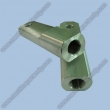OVERVIEW
Electroforming is the process of depositing thin layers of metal onto a mandrel through electroplating, dissolving the mandrel chemically, and leaving the plating as the final electroformed product.
MACHINING
The mandrel is the base machined component, typically made from Aluminum 6061T or stainless steel, which defines the internal geometry of an electroform. In component manufacturing, it is typically more difficult to hold internal dimension to tight tolerances than external dimensions. Since electroforms are based on the machining tolerances of the external mandrel geometry, the internal dimensions are precise. With advancements in CNC machining parts, miniature, specialized components can be machined, plated, and converted into custom electroforms. Currently, electroforms can be manufactured to less than a 0.5mm diameter with a wall thickness of less than 0.008mm. Special tooling can be utilized for custom configurations in order to match design specifications. Multiple machined components can be assembled together to create more complex shapes. The result is a seamless electroformed assembly.
PLATING
During the plating process, the mandrel acts as the cathode while the source of the electroform material is the anode. Controlling the time, current and current density in the plating tank will control the thickness of the electroform. Constant monitoring of the chemistry within the tank results in a more precise component.
The metal(s) selected for plating are chosen based on parameters defined by the customer. The most popular materials for electroforms are nickel, copper, gold, and silver. Different forms of nickel as well as a nickel cobalt alloy are available to meet the installation and strength requirements. Nickel is a cost effective material, operates at cryogenic temperatures, and produces low leak rates. Copper, gold, or silver can be used to meet other design specifications such as media compatibility, reflectivity, conductivity, and tensile strength. For example, a gold-plated surface will increase conductivity for bellows electrical contact applications. The nickel base material gives an electroform its strength, while the gold finish reduces signal loss.
In addition, special surface finishes can be applied internally or externally to the electroform assembly. For optical applications, a mirror finish (4 R.M.S) can be required to increase reflectivity; in infrared filtering applications, a blackening can be added to the internal surface to limit the range of light passing through the assembly.
REMOVAL OF THE MANDREL
After the plating process, the mandrel will need to be removed from the assembly. For an aluminum mandrel, this is accomplished by exposing a portion of the mandrel; for example, the mandrel is made slightly longer than required when manufacturing an electroformed bellows. The ends are trimmed after plating to the desired length to expose the mandrel. The assembly is then put into a caustic soda to chemically remove the mandrel, leaving only the electroformed bellows.
SUB-ASSEMBLY LEVEL
Depending on the application an electroform is either a stand-alone item or a component to be integrated into an assembly. Electroforms can be installed using epoxy, solder, or welding, depending on the chemical composition of the component and the material that it will adhered to.
APPLICATIONS
Electroforms can be used in applications that require extremely tight tolerances, miniature sizes, and a wide operating temperature range. Here are a few examples.
Bellows are flexible tubes that can be used in a variety of applications including pressure, volume and temperature compensation, actuators, couplings, and more. Electrodeposited bellows allow for much smaller sizes and tighter tolerances than comparable technologies.
Electrical Contacts created by an electroforming process allow for an electrical connection to be made between miniature components. If a bellows is integrated into the electrical contact, it can compensate for misalignments and offsets. A gold-plated surface increases conductivity and reduces signal loss.
Electromagnetic shielding is a common requirement in today's digital world. Electroformed assemblies can protect against electromagnetic and radio frequency interference with less weight than materials such as stainless steel and with greater survivability than brass plates.
Reflectors with mirror finishes use electroforming technology for its structural rigidity, light-weight construction and surface finish to transmit light in the direction and magnitude required.
Cold Shields are complex assemblies used in microwave devices to protect against unwanted electromagnetic radiation. Baffles, gold external finishes, blackened internal finishes, and cryogenic temperature ratings make electroforming technology an ideal fit for the design of cold shields.
Waveguides are used to manage electromagnetic waves. Electroforming technology is chosen to add flexibility for non-stationary applications and give tight tolerances to the internal geometry.
Forming dies and molds are typically manufactured using plastic, yet electroforms can be used for applications that require tighter tolerances than plastics can provide. For example, many medical devices rely on electroformed molds to control the shape of catheter tips. Also, automotive plants use electroformed components to create consistently shaped interior machine components.







